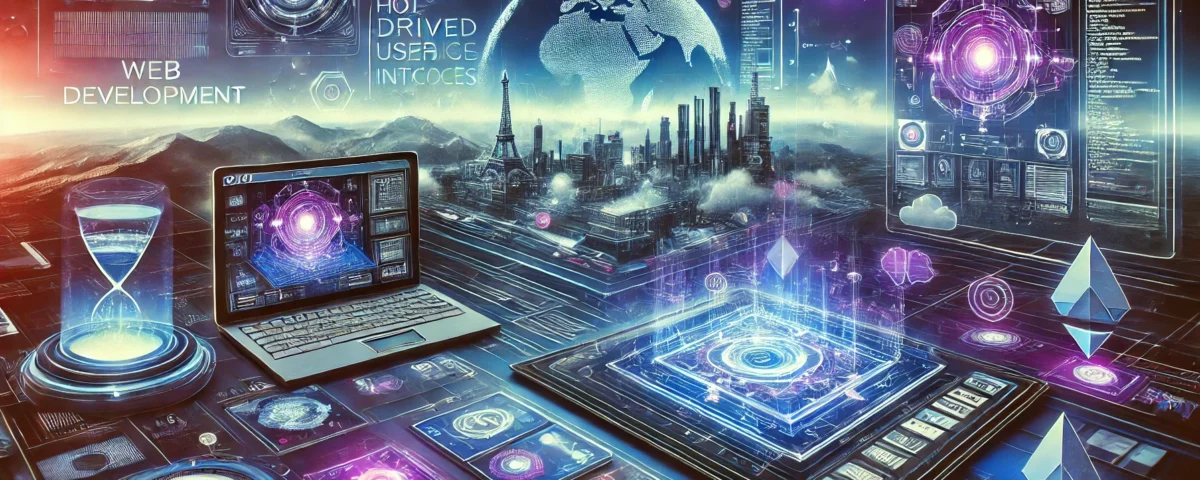
SEO strategies for 2025: How to Rank Higher on Google
March 13, 2025Future of Web Development 2025: Key Trends Shaping the Industry
The web development landscape is constantly evolving, with new technologies and trends shaping the way businesses build and optimize their online presence. As we step into 2025, several game-changing advancements are set to redefine how websites and applications are created, offering faster, more efficient, and user-friendly experiences. Let’s explore the key web development trends 2025 to watch.
1. AI-Powered Web Development
Artificial Intelligence (AI) is revolutionizing web development by automating design, code generation, and user experience personalization. AI-driven website builders, chatbots, and automated content creation tools allow businesses to streamline their web development processes while improving engagement and accessibility.
What to Expect:
- AI-generated code and website layouts.
- Chatbots and virtual assistants with natural language processing (NLP).
- AI-driven personalization for enhanced user experiences.
2. Progressive Web Apps (PWAs)
Progressive Web Apps (PWAs) combine the best of websites and mobile apps, offering fast loading speeds, offline functionality, and improved user engagement. PWAs reduce the need for separate mobile apps, making it easier for businesses to provide a seamless experience across all devices.
Why It Matters:
- Faster and more responsive than traditional websites.
- Enhanced offline capabilities.
- Lower development costs compared to native apps.
3. Voice Search Optimization
With the growing popularity of smart assistants like Siri, Alexa, and Google Assistant, voice search is becoming a crucial factor in web development. Websites must be optimized for voice-based queries to remain competitive in search rankings.
How to Adapt:
- Implement structured data and schema markup.
- Optimize content for conversational queries.
- Improve website speed and mobile responsiveness.
4. No-Code & Low-Code Development
The rise of no-code and low-code platforms allows businesses to create websites and applications without deep technical expertise. These platforms enable faster development cycles and empower non-developers to build functional web applications.
Benefits:
- Speeds up development and reduces costs.
- Increases accessibility for startups and small businesses.
- Allows for rapid prototyping and iterations.
5. Web 3.0 & Decentralized Applications (DApps)
Web 3.0 is the next evolution of the internet, emphasizing decentralization, blockchain technology, and user ownership of data. Decentralized applications (DApps) are gaining traction, offering greater security, transparency, and control over digital assets.
Key Features:
- Blockchain-based authentication and transactions.
- Decentralized hosting and cloud storage.
- Enhanced data privacy and user control.
6. Cybersecurity & Data Privacy Enhancements
With increasing cyber threats, web developers must prioritize security and data protection. Implementing advanced security measures such as multi-factor authentication, encryption, and secure coding practices is essential in 2025.
Best Practices:
- Regular security audits and vulnerability testing.
- Implementation of biometric authentication.
- Compliance with global data protection regulations (e.g., GDPR, CCPA).
7. Enhanced Motion UI & Micro-Interactions
User experience is evolving with the integration of motion UI and micro-interactions that make websites more engaging and intuitive. From smooth transitions to animated elements, these enhancements improve user interaction and retention.
Why It’s Important:
- Increases user engagement and time spent on site.
- Enhances brand storytelling through interactive design.
- Provides visual feedback that guides users seamlessly.
Final Thoughts
The future of web development 2025 is all about speed, intelligence, security, and user-centric design. Businesses that adopt these trends will stay ahead of the competition, offering cutting-edge digital experiences that drive engagement and growth. Whether it’s through AI-driven development, PWAs, Web 3.0, or enhanced cybersecurity, the key is to embrace innovation and adapt to the ever-changing digital landscape.





